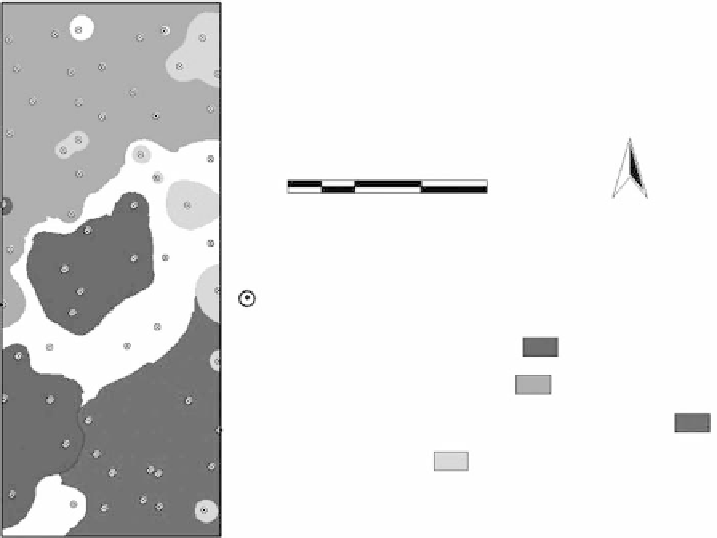Geoscience Reference
In-Depth Information
Management Recommendations
for SSMUs
(Study site: Broadview Water District, Firebaugh, CA)
N
100
0
100
200
Meters
EC
a
-directed soil sample locations
(a) Leaching fraction:reduce LF to < 0.4
(b) Salinity: reduce EC
e
to < 7.17 dS/m
(c) Te xture: coarser texture requires more frequent irrigation
(d) pH: reduce pH to < 7.9
fIGURe 16.4
Site-specific management units for a 32.4 ha cotton field in the Broadview Water District of
central California's San Joaquin Valley. Recommendations are associated with the SSMUs for (a) leaching
fraction, (b) salinity, (c) texture, and (d) pH. (Taken from Corwin, D.L., Lesch, S.M.,
Comput. Electron. Agric.
46(1-3), 11-43, 2005a.)
Subsequently, Corwin and Lesch (2005a) delineated SSMUs, which are depicted in Figure 16.4.
Figure 16.4 indicates the areas pertinent to the above recommendations. All four recommenda-
tions can be accomplished by improving water application timing and distribution with variable-
rate irrigation technology (Evans, 1997; Perry et al., 2003) and by the precision application of soil
amendments. Highly leached zones were delineated where the LF needed to be reduced to <0.5;
high-salinity areas were defined where the salinity needed to be reduced below the salinity threshold
for cotton, which was established from Equation (16.3) to be EC
e
= 7.17 dS m
−1
for this field; areas of
coarse texture were defined that needed more frequent irrigations; and areas were pinpointed where
the pH needed to be lowered below a pH of 8 with a soil amendment such as OM. This work brought
an added dimension because it delineated within-field units where associated site-specific manage-
ment recommendations would optimize the yield, but it still falls short of integrating meteorologi-
cal, economic, and environmental impacts on within-field crop-yield variation. Furthermore, these
SSMUs have not been tested to evaluate whether their use would actually increase yield.
In instances where crop yield correlates with EC
a
, the spatial distribution of EC
a
provides a
means of directing soil sampling to determine edaphic properties influencing yield. This informa-
tion provides a basis for delineating SSMUs. The method for delineating SSMUs consists of the fol-
lowing general steps: (1) intensive yield monitoring and EC
a
survey; (2) EC
a
-directed soil sampling;
(3) statistical analyses to determine the correlation between EC
a
-directed soil sampling and crop
yield, to identify the significant soil properties influencing crop yield, and to develop a crop yield
response model adjusted for spatial autocorrelation; and (4) use of GIS to define SSMUs based on
scatter plots and crop yield response model.
Even though EC
a
-directed soil sampling provides a viable means of identifying some soil prop-
erties that influence within-field variation of yield, it is only one piece of a complicated puzzle of
interacting factors that result in observed within-field crop variation. Crop yield is influenced by

